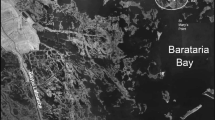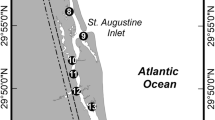Abstract
We sampled experimental research areas in the Barataria Basin of Louisiana, USA to examine the effects of structural marsh management on habitat use by small nekton (>100 mm Total Length or Carapace Width). The research areas consisted of two control (unmanaged) marshes and two impounded (managed) marshes; managed areas were surrounded by levees with water-control structures constructed by the U.S. Department of Interior, National Biological Survey. We sampled nekton with 1-m2 enclosure samplers in 1995 just as a drawdown was initiated (March) and after two months of drawdown (May); a drawdown is an active management technique in which water is allowed to flow out of, but not back into, the impoundment. Samples were collected randomly from all available habitat types (shallow open water, submerged aquatic vegetation (SAV), and intertidal marsh) in the managed and unmanaged areas. In March, the densities of resident taxa (e.g., Lucania parvac rainwater killifish and Palaemonetes paludosus riverine grass shrimp), which complete their life cycles within the estuary, were significantly greater in the managed areas compared to the unmanaged areas. The densities of most resident species were either similar in managed and control areas, or significantly greater in control areas during the drawdown (May). In contrast to residents species, the transient fishery species (e.g., Callinectes sapidus blue crab and Farfantepenaeus aztecus brown shrimp) reproduce outside of the marsh system and recruit to these areas as young. The densities of these transient species were significantly higher in unmanaged areas compared to managed areas during both sampling periods. We estimated standing crop (number or biomass of nekton per hectare of marsh area) by combining habitat densities with the area of different habitat types. The standing crops of transient species also were substantially greater in unmanaged than managed areas. We conclude that the restricted water exchange in marshes under structural marsh management diminishes recruitment and standing stocks of species that must migrate from coastal spawning sites to marsh nurseries. Even when water-control structures were open, the densities of these transient species were low inside managed areas. In contrast to the negative effect of management on transient species, the resident fish and crustacean populations seemed to flourish in the managed areas when a drawdown was not in effect. Following two months of a drawdown, however, the populations of residents appeared similar inside and outside managed areas. Increases in submerged aquatic vegetation (SAV) within ponds occurred outside the managed areas during the study period, but not inside managed areas. Because many resident species were closely associated with the SAV, the effect of management on SAV may have been responsible for the distribution patterns of resident species.
Similar content being viewed by others
References
Baltz, D.M., Rakocinski, C. and Fleeger, J.W. 1993. Microhabitat use by marsh-edge fishes in a Louisiana estuary. Environ. Biol. Fish. 36: 109–126.
Boesch, D.F., Josselyn, M.N., Mehta, A.J., Morris, J.T., Nuttle, W.K., Simenstad, C.A. and Swift, D.J.P. 1994. Scientific Assessment of Coastal Wetland Loss, Restoration and Management in Louisiana. J. Coastal Res. Special Issue, No. 20. v + 103 pp.
Boyer, M.E. 1997. The effect of long-term marsh management on land-loss rates in coastal Louisiana. Environ. Mgmt. 21: 97–104.
Britsch, L.D. and Dunbar, J.B. 1993. Land loss rates: Louisiana coastal plain. J. Coastal Res. 9: 324–338.
Castellanos, D.L. 1997. Nekton use of submerged aquatic vegetation, marsh, and shallow unvegetated bottom in a Louisiana tidal freshwater ecosystem. M.S. Thesis, University of Southwestern Louisiana, Lafayette. 79 pp.
Cowan, J.H., Jr., Turner, R.E. and Cahoon, D.R. 1988. Marsh management plans in practice: Do they work in coastal Louisiana, USA? Environ. Mgmt. 12: 37–53.
Hartman, R.D., Bryan, C.F. and Korth, J.W. 1987. Community structure and dynamics of fishes in a Southeast Texas estuary. U.S. Fish and Wildlife Service, Albuquerque, NM. 116 pp.
Herke, W., Rogers, B. and Grimes, J. 1984. A study of the seasonal presence, relative abundance, movements, and use of habitat types by estuarine-dependent fishes and economically important decapod crustaceans on the Sabine National Wildlife Refuge. Final report for Cooperative Agreement FWS No. 14–16–0009–79–1003 between the U.S. Dept. of the Interior, Fish andWildlife Service and Louisiana State University. Louisiana Cooperative Fishery Research Unit, Louisiana State University Agricultural Center. 111 pp.
Herke, W.H., Wengert, M.W. and LaGory, M.E. 1987. Abundance of young brown shrimp in natural and semi-impounded marsh nursery areas: relation to temperature and salinity. Northeast Gulf Sci. 9: 9–28.
Herke, W.H., Knudsen, E.E., Knudsen, P.A. and Rogers, B.D. 1992. Effects of semi-impoundment of Louisiana marsh on fish and crustacean nursery use and export. N. Am. J. Fish. Mgmt. 12: 151–160.
Hoese, H.D. and Konikoff, M. 1995. Effects of marsh management on fisheries organisms: the compensatory adjustment hypothesis. Estuaries 18: 180–197.
Jordan, F., Coyne, S. and Trexler, J.C. 1997. Sampling fishes in vegetated habitats: effects of habitat structure on sampling characteristics of the 1-m2 throw trap. Trans. Am. Fish. Soc. 126: 1012–1020.
Knudsen, E., Paille, R., Rogers, B. and Herke, W. 1989. Effects of a fixed-crest weir on brown shrimp Penaeus aztecus growth, mortality, and emigration in a Louisiana coastal marsh. N. Am. J. Fish. Mgmt. 9: 411–419.
Kushlan, J.A. 1981. Sampling characteristics of enclosure fish traps. Trans. Am. Fish. Soc. 110: 557–562.
McGovern, J.C. and Wenner, C.A. 1990. Seasonal recruitment of larval and juvenile fishes into impounded and non-impounded marshes. Wetlands 203–221.
Minello, T.J. 1993. Chronographic tethering: a technique for measuring prey survival time and testing predation pressure in aquatic habitats. Mar. Ecol. Prog. Ser. 101: 99–104.
Minello, T.J. 1999. Nekton densities in shallow estuarine habitats of Texas and Louisiana and the identification of Essential Fish Habitat. In: Benaka, L. <nt>(ed.)</nt>. Fish Habitat: Essential Fish Habitat and Habitat Rehabilitation. American Fisheries Society, Symposium 22: 43–75.
Minello, T.J. and Zimmerman, R.J. 1983. Fish predation on juvenile brown shrimp, Penaeus aztecus Ives: the effect of simulated Spartina structure on predation rates. J. Exp.Mar. Biol. Ecol. 72: 211–231.
Minello, T.J. and Zimmerman, R.J. 1985. Differential selection for vegetative structure between juvenile brown shrimp (Penaeus aztecus) and white shrimp (P. setiferus), and implications in predator-prey relationships. Est. Coast. Shelf Sci. 20: 707–716.
Minello, T.J., Zimmerman, R.J. and Czapla, T.C. 1989. Habitatrelated differences in diets of small fishes in Lavaca Bay, Texas, 1985–1986. NOAA Technical Memorandum, NMFS-SEFC-236. 16 pp.
Montague, C.L., Zale, A.V. and Percival, H.F. 1987. Ecological effects of coastal marsh impoundments: a review. Environ. Mgmt. 11: 743–756.
Penland, S., Mendelssohn, I., Wayne, L. and Britsch, D. 1996. Natural and human causes of coastal land loss in Louisiana. Coastal Studies Institute and Wetland Biogeochemistry Institute, Louisiana State University, Baton Rouge. 25 pp.
Perez-Farfante, I. and Kensley, B. 1997. Penaeoid and sergestoid shrimps and prawns of the world; keys and diagnoses for the families and genera. Mémoires du Muséum National d'Histoire Naturelle, Tome 175, 233 pp.
Reed, D.J., De Luca, N. and Foote, A.L. 1997. Effect of hydrologic management on marsh surface sediment deposition in coastal Louisiana. Estuaries 20: 301–311.
Rogers, B.D. and Herke, W.H. 1985. Estuarine-dependent fish and crustacean movements and weir management. In: Bryan, C.F., Zwank, P.J. and Chabreck, R.H. <nt>(eds.)</nt>. Proceedings of the Fourth Coastal Marsh and Estuary Management Symposium. pp. 201–219. Louisiana State University Agricultural Center, Louisiana Cooperative Fish and Wildlife Research Unit, Baton Rouge, LA.
Rogers, B.D., Herke, W.H. and Knudsen, E.E. 1992a. Effects of three different water-control structures on the movements and standing stocks of coastal fishes and macrocrustaceans. Wetlands 12: 106–120.
Rogers, D.R., Rogers, B.D. and Herke, W.H. 1992b. Effects of a marsh management plan on fishery communities in coastal Louisiana. Wetlands 12: 53–62.
Rogers, D.R., Rogers, B.D. and Herke, W.H. 1994. Structural marsh management effects on coastal fishes and crustaceans. Environ. Mgmt. 18: 351–369.
Rozas, L.P. and Hackney, C.T. 1983. The importance of oligohaline estuarine wetland habitats to fisheries resources.Wetlands 3: 77–89.
Rozas, L.P. and Reed, D.J. 1994. Comparing nekton assemblages of subtidal habitats in pipeline canals traversing brackish and saline marshes in coastal Louisiana. Wetlands 14: 262–275.
Rozas, L.P. and Minello, T.J. 1997. Estimating densities of small fishes and decapod crustaceans in shallow estuarine habitats: a review of sampling design with focus on gear selection. Estuaries 20: 199–213.
Rozas, L.P. and Minello, T.J. 1998. Nekton use of salt marsh, seagrass, and nonvegetated habitats in a south Texas (USA) estuary. Bull. Mar. Sci. 63: 481–501.
Sokal, R.R. and Rohlf, F.J. 1981. Biometry. 2nd Edition, W. H. Freeman and Co., San Francisco, CA. 859 pp.
Thomas, J.L. 1989. A comparative evaluation of Halodule wrightii Aschers, Spartina alterniflora Loisel and bare sand as nursery habitat for juvenile Callinectes sapidus (Rathbun). M.S. thesis, Texas A&M University, College Station. 119 pp.
Thomas, J.L., Zimmerman, R.J. and Minello, T.J. 1990. Abundance patterns of juvenile blue crabs (Callinectes sapidus) in nursery habitats of two Texas bays. Bull. Mar. Sci. 46: 115–125.
Turner, R.E. 1997. Wetland loss in the northern Gulf of Mexico: multiple working hypotheses. Estuaries 20: 1–13.
U.S. Department of Commerce. 1997. Fisheries of the United States, 1996. Current Fishery Statistics No. 9600. Fisheries Statistics Division, Silver Spring, MD. 169 pp.
Weaver, J.E. and Holloway, L.F. 1974. Community structure of fishes and macrocrustaceans in ponds of a Louisiana tidal marsh influenced by weirs. Contr. Mar. Sci. 18: 57–69.
Weinstein, M.P., Weiss, S.L., Hodson, R.G. and Gerry, L.R. 1980. Retention of three taxa of postlarval fishes in an intensively flushed tidal estuary, Cape Fear River, North Carolina. Fish. Bull. U.S. 78: 419–436.
Yakupzak, P.M., Herke, W.H. and Perry, W.G. 1977. Emigration of juvenile Atlantic croakers, Micropogon undulatus, from a semiimpounded marsh in southwestern Louisiana. Trans. Am. Fish. Soc. 106: 538–544.
Zimmerman, R.J. and Minello, T.J. 1984. Densities of Penaeus aztecus, P. setiferus and other natant macrofauna in a Texas salt marsh. Estuaries 7: 421–433.
Zimmerman, R.J., Minello, T.J., Castiglione, M. and Smith, D. 1990a. Utilization of marsh and associated habitats along a salinity gradient in Galveston Bay. NOAA Technical Memorandum, NMFS-SEFC-250. 68 pp.
Zimmerman, R.J., Minello, T.J. and Rozas, L.P. 1999. Salt marsh linkages to productivity of penaeid shrimps and blue crabs in the Northern Gulf of Mexico. In: Weinstein, M.P. (ed.), Concepts and Controversies in Tidal Marsh Ecology. New Jersey Sea Grant, Fort Hancock (in press).
Zimmerman, R.J., Minello, T.J., Smith, D. and Castiglione, M. 1990b. The use of Juncus and Spartina marshes by fisheries species in Lavaca Bay, Texas, with reference to effects of floods. NOAA Technical Memorandum, NMFS-SEFC-251. 40 pp.
Zimmerman, R.J., Minello, T.J. and Zamora, G. 1984. Selection of vegetated habitat by brown shrimp, Penaeus aztecus, in a Galveston Bay salt marsh. Fish. Bull. U.S. 82: 325–336.
Author information
Authors and Affiliations
Rights and permissions
About this article
Cite this article
Rozas, L., Minello, T. Effects of structural marsh management on fishery species and other nekton before and during a spring drawdown. Wetlands Ecology and Management 7, 121–139 (1999). https://doi.org/10.1023/A:1008434727703
Issue Date:
DOI: https://doi.org/10.1023/A:1008434727703




